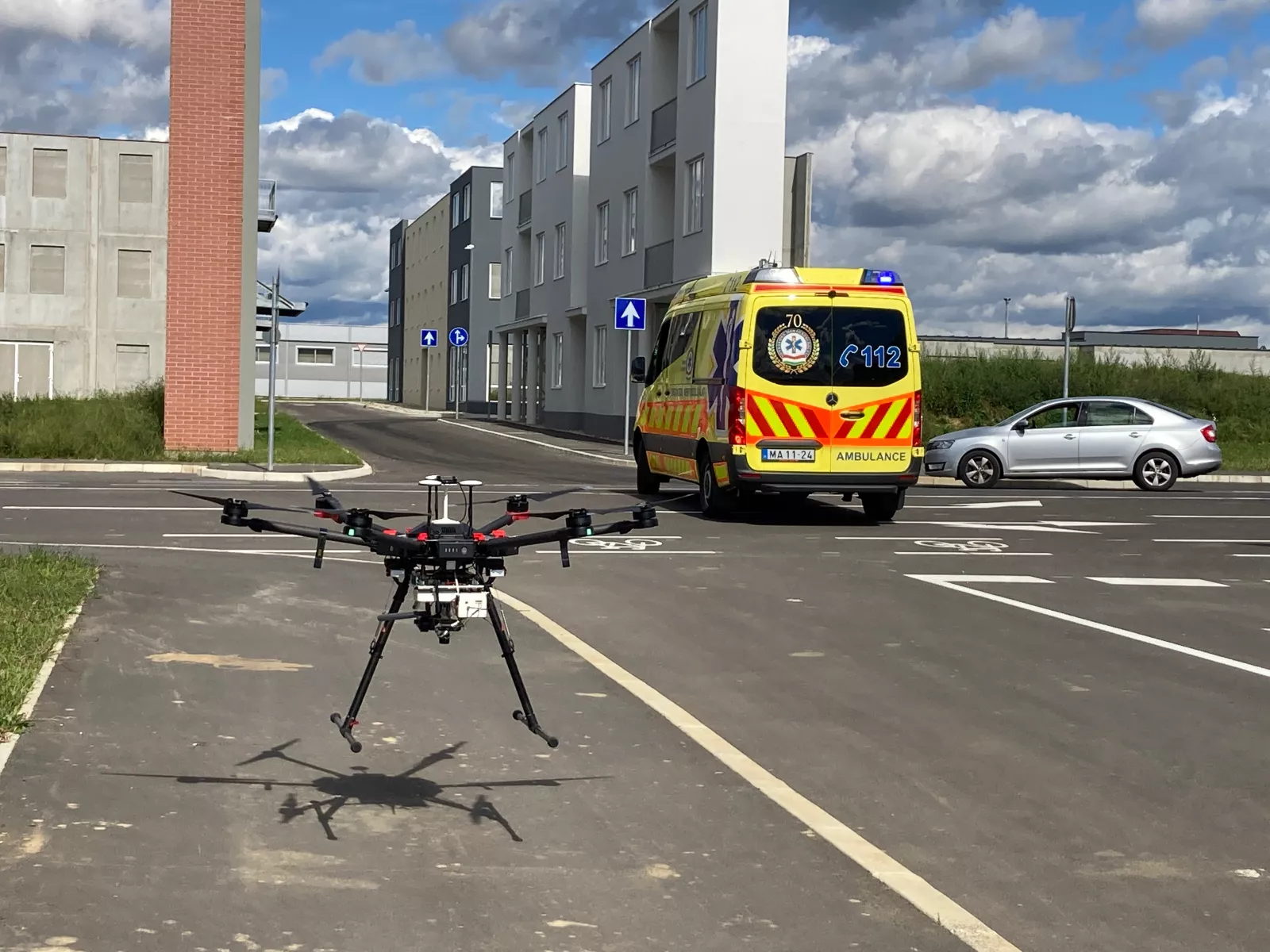
In the frame of the ”Week of Safety” event-series the researchers of the Széchenyi István University (Győr, Hungary) and of the Institute for Computer Science and Control (SZTAKI, Budapest, Hungary) were given the opportunity to demonstrate to the public the results of their joint development efforts concerning a forerunner drone. The live demo was carried out with the active participation of the Hungarian National Ambulance Service (HNAS); more specifically, one of their ambulance cars was accompanied in the air and was safeguarded from above by the aforementioned drone.
The goal of this world-unique forerunner drone development is to provide a drone with the capability so that it can accompany in the air and safeguard from above a deployed first-response ground vehicle (e.g., an ambulance, a fire brigade, or a police car). The drone, which is equipped with a camera, flies preferably in front of the deployed ground vehicle. In this way, areas hidden from the driver's view can be surveiled in advance, and the driver can be warned of the dangers looming there. By the outlined accompanying and safeguarding missions of the forerunner drone, fatal accidents such as the ambulance-accident in Csepel (Budapest, Hungary) in May 2022 can be prevented.
The test and live demonstration of the forerunner drone was carried out with the sponsoship of the Association of Hungarian Insurance Companies (MABISZ). The test and demo took place in an urban environment provided by the Smart City area of the Zalaegerszeg Automotive Test Track. The test and the demo showed that an approaching car hidden from the view of the deployed ambulance car’s driver by building walls can be discovered and located by the forerunner drone. Upon detection the approaching car, the ambulance car’s driver can be warned in time to take appropriate action (e.g., stop). In this way, thanks to the warning sent by the forerunner drone, the crash between the approaching car and the ambulance car can be avoided. In this manner the main research question, i.e., the feasibility of forerunner concept, has been positively answered. The photos taken at the test and demo can be viewed here. The video taken there is shown below..
It is important to note here that with the drone used (DJI M600) in the experiments only urban tests at low speeds can be performed due to its limited physical capabilities. Therefore, higher-speed manoeuvres were tested by the development team in simulations. Furthermore, in addition to various technical issues, the application of the system in real missions will also require the resolution of a number of legal and regulatory issues. These include issues concerning drone flights over cities and highways, as well as issues arising from taking continuous video recordings of the traffic using cameras.
The presentation shown in the recording is the result of the project-section entitled "Forerunner drone research" of the subproject FT2 "Autonomous Near-Earth Aerial Solutions" within the framework of the project “Developing innovative automotive testing and analysis competencies in the West Hungary region based on the infrastructure of the Zalaegerszeg Automotive Test Track, GINOP-2.3.4-15-2020-00009” running at Széchenyi István University.
Sub-project leaders: Dr. Péter Bauer (ELKH SZTAKI senior research fellow), István Drotár (Széchenyi István University)
Participants: Dr. Antal Hiba, Dr. Attila Gáti, Mihály Nagy, Ádám Kisari, Ernő Simonyi, Gergely István Kuna

Details and progress of the forerunner drone project can be followed through the published news:
Successful testing of the on-board system (April 2022):
Successful autonomous flights (May 2022):
The successful tracking of a ground vehicle (July 2022) was reported on the Autonomous Systems National Laboratory web-site.
https://autonom.nemzetilabor.hu/news/ground-vehicle-uav-cooperative-tests
Zalazone Smart City survey flights (July 2022):